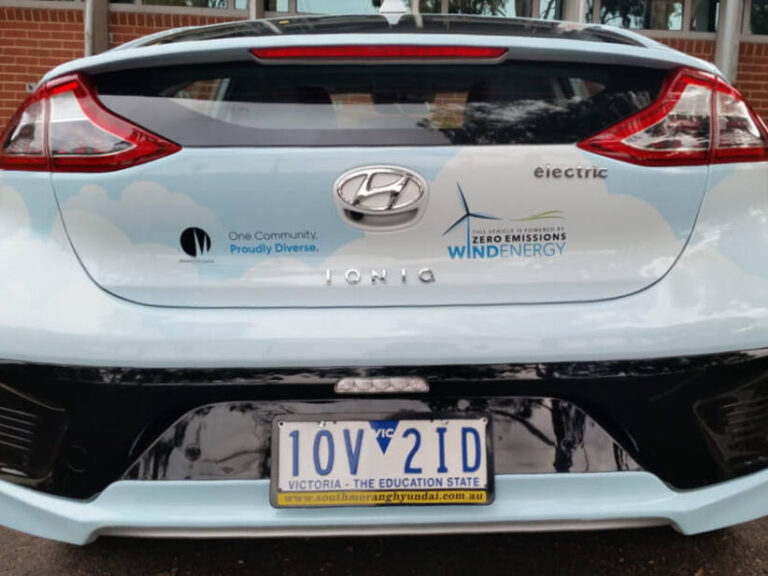Moreland City Council has been a pioneer of the electric vehicle movement in Australia. Making its mark within local government as an eco-mobility leader and turning heads outside the sector as well, Moreland has demonstrated they don’t just talk about going zero emissions, they act upon it too. One of the drivers behind Moreland’s push to go green is Stuart Nesbitt. As the Council’s Climate Change Technical Officer, Stuart has been integral to the Council’s sustainability efforts pursuing not only cleaner vehicles for their own fleet but getting the local community on board with the electric revolution as well. We spoke to Stuart about Moreland’s journey over the past eight years – from its first interaction with EVs in 2012 to its 22 strong fleet of electric vehicles today – and what’s next in store for this progressive Council.
Hyundai: Stuart, since Moreland’s early days first investigating EVs how have you secured buy in from Council and what policies and programs have you put in place to get where you are today?
Stuart: Moreland’s zero emissions transport journey started with our involvement in the Victorian government’s EV trial in 2012. This gave Council a real-world opportunity to assess the feasibility of operating EVs in our fleet.
The trial was a huge success and paved the way for the purchase of Council’s first EV in 2013 and the development of a plan to transition our fleet away from fossil fuelled vehicles. This included commissioning a fleet EV feasibility study in 2014 which showed a positive business case and the potential for emissions reductions by going zero emissions.
After successfully operating four EV’s in the fleet for more than four years, in 2017 Council called for a complete overhaul of our policy settings and the creation of a blueprint to gradually transition the fleet to zero emissions.
As a result, in April 2018 we mandated the purchase of zero emissions vehicles in the first instance during vehicle procurement. In terms of emissions standards, it’s considered one of the most progressive fleet vehicle policies in Australia and in the first twelve months led to a quadrupling of EV’s in our light vehicle fleet.
Hyundai: What is the current size and composition of Moreland’s vehicle fleet and how do you envisage this to change in future?
Stuart: The Council’s light vehicle fleet, both passenger and light commercial vehicles, includes 151 vehicles, 22 of which are zero emissions. Supporting this is 11 private and 14 public EV charging infrastructure locations across the municipality.
We are continuously identifying new opportunities to embed charging infrastructure across the municipality and our ESD minimum standards building policy mandates the installation of EV charging infrastructure attached to new Council buildings or major building renovations.
Hyundai: Your EV charging facilities are also open to the public – how do you manage this and what has been the feedback from Moreland residents?
Stuart: Our public EV charging infrastructure is owned and operated by Council on Council land and comprises nine Level 2 stations and five DC fast charging stations.
All of our stations are Type 2 or CCS2 and are permanently tethered for ease of use and free to use with time restrictions. The stations are managed under the Chargefox network.
Feedback from network users is incredibly positive. Being an early adopter in this space has provided us with an enviable reputation as a leader in demonstrating and promoting the transition to zero emission vehicles.
Hyundai: What were your top priorities when selecting an EV model for your fleet and what was your process to assess the models on the market?
Stuart: Our light vehicle policy follows a ‘stage gate’ process that we implement during procurement.
Firstly, the vehicle must first be fit for purpose, that is it must meet the specific requirements of the role it will be used for. Following this, it must meet minimum safety standards – 5 star ANCAP for passenger vehicles and 4 star for light commercial.
The third stage gate is emissions. It must be zero emissions in the first instance where if an entry level zero emissions vehicle is available that meets the first two stage gates it must be purchased irrespective of purchase price.
Where a zero emissions vehicle is not available, for passenger vehicles we preference those that are no more than 100gms CO₂/km as per the Green Vehicle Guide, and the lowest CO₂ emissions at the time of purchase for light commercial vehicles. Diesel passenger vehicles are banned.
Hyundai: What has been your biggest challenge to date in integrating EVs and their infrastructure into your fleet?
Stuart: While there was some internal resistance to the transition to zero emissions vehicles initially, the introduction of the Council mandate and the establishment of policies and procedures were critical for the push towards a cleaner fleet gaining momentum.
Hyundai: What’s next on the horizon for Moreland in sustainability both in transport and more broadly?
Stuart: We have drawn the conclusion that electric drivetrains powered by renewable energy sources are the key to a zero emissions fleet operation. We see hydrogen as an important next step to transition our heavy fleet to zero emission and we have been heavily involved in initiatives to promote the use of green hydrogen as a transport fuel, particularly heavy transport such as council’s waste vehicles.
More broadly, our view is that renewable powered battery electric vehicles will likely fill the majority of the personal transport space and fuel cell electric vehicles will likely fill the majority of the commercial transport space.
Ultimately, Council sees both technologies playing specific roles in a zero emissions transport future and supports them as equally important technologies.
This article was originally published by Hyundai.







